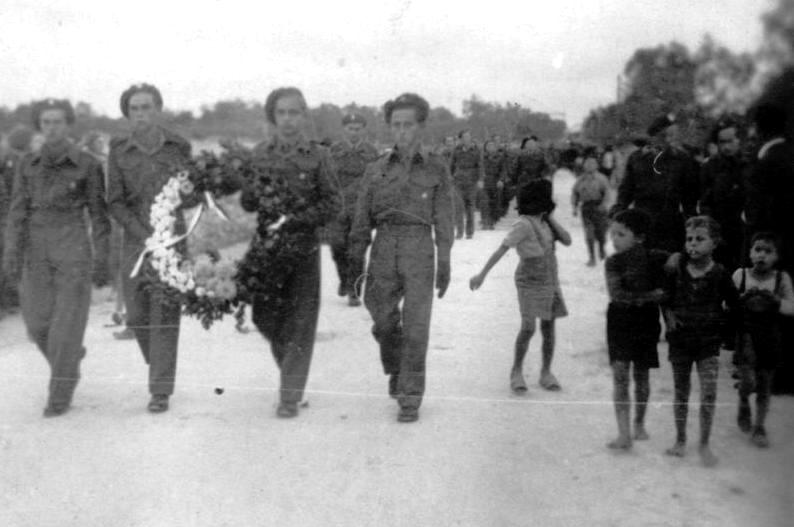
Polish World War II Commands

Figure 1.--These Polish soldiers after World War II are in Casarano, Italy. They fought in the British 8th Army in Italy. Casarano is a big village in Apulia region (south eastern Italy). The photograph was taken November 1-2, 1945 while the soldiers celebrated All Souls' Day for comrades theyb lost. Polish soldiers in the West had a difficult decesion. Many were from areas annexed by the Soviet Union. And even those from Western Poland were in great danger. Many veterans who fiught in the West were arrested or otherwise abused when they returned to Communist Poland.
|
|
Eventhough Poland was occupied by the NAZIs and Soviets in the first military operation of the War, substantial Polish forces fought under British and Soviet commands on the western and eastern fronts and made important contributions. Poland in manpower terms was the fourth largest contributor to the Allied cause in Europe. Some Poles managed to escape to the West after the invasion and occupation of their country (September 1939). The fought in France (May-Jue 1940). Polish pilots fought in the Battle of Britain (July-September 1940). The Polish POWs taken by both the NAZIs and Soviets were treately brutally. The Germans did not follow the Geneva Conventions in their treatment of Polish POws. Few managed to survive the German camps. The Soviets also treated the POWs they took brutally. The NKVD shot many officers. Those not short were poorly treated ahd fed. After the NAZI invasion of the Soviet Union (June 1941), Stalin releaed the Polish PWs from the Gulag and gave them a choice of fighting with the Red army or the Allied in the West. The Polish armies on the eastern and western fronts thus fought under separate commands during the war. This of course was the result of the political division.
Western Front (1940-45)
The Poles fought with distinction with the Allies in the fefense of France and Britain (1940), North Africa (1942-43), Italy (1944), and France (1944). Polish soldiers reached France after the German invasion of their Poland. They fought with the French during the German Western OKffensive. Many were taken captive there, but some made it to Britain after the collapse of the French Army. Two Polish squadrons played a key role in the Battle of Britain (1940). Substantial Polish military operations were not possible until the NAZI invasion of the Soviet Union (June 1941). Stalin releasedthe POWs in Soviet custody. They were allowed to join the Red Army or join the British who were fighting the Germans and Italians in North Africa. It was Polish soldiers who finally took Casino and broke the Gustaf Line (1944). There were about 0.2 million Polish soldiers who served with the British Army.
Eastern Front (1941-45)
Renewed Polish resistance on the Eastern Front did not occur until the NAZIs invaded the Soviet Union (June 1941). The interened Polish POWs were given a choice of fighting with the Red Army or Westrn Allies. The Poles who chose to join the Red Army were formed into a separate Polish army. There was shortage of officers, in part because of the Soviet executions of Polish officers. So many officers in the Polish Army were Soviets from the Red Army. Stalins concern with controlling the Poles was another factor. This Polish Army was theoretically put under the command of the Soviet-backed provisional created in Lublin. After the Red Army moved into eastern Poland, a recruiting drive was launched. Thes new recruits were added to the existing Polish Army and renamed Polish First Army and placed under the command of General Zygmunt Berling, who had been an officer in the opre-War Polish Army. The Polish First Army later was united with the communist resistance command loyal to the Lublin Government to form the Polish Armed Forces (Wojska Polskie). As more of Poland was liberated, two additional Polish armies were formed (1944). As in the West, the Poles once equipped with modern weapons fought with destinction in the drive west against the NAZIs. The Soviets gave considerable effort to the indoctrination of the Polish soldiers. Soviet officers had major command responsibilities throught the Polish units. In addition to military officrs, about 5,000 to 6,000 political officers were appointed to oversee the indoctrination of the Polish soldiers. We are not sure how effective they were. We do notbknow to what extent the Polish soldiers accepted the Communist ideology or just realized the reality of Soviet control.
HBC

Navigate the Boys' Historical Clothing Web Site:
[Return to Main Polish World War II Page]
[Return to Main World War II country page]
[Return to Main Polish page]
[Introduction]
[Activities]
[Biographies]
[Chronology]
[Clothing styles]
[Countries]
[Girls]
[Bibliographies]
[Contributions]
[FAQs]
[Glossary]
[Images]
[Links]
[Registration]
[Tools]
[Boys' Clothing Home]
Created: 4:04 AM 8/3/2010
Last updated: 4:04 AM 8/3/2010



